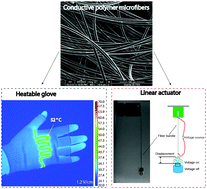High-ampacity conductive polymer microfibers as fast response wearable heaters and electromechanical actuators†
Abstract
Conductive fibers with enhanced physical properties and functionalities are needed for a diversity of electronic devices. Here, we report very high performance in the thermal and mechanical response of poly(3,4-ethylenedioxythiophene)/poly(styrenesulfonate) (PEDOT/PSS) microfibers when subjected to an electrical current. These fibers were made by combining the hot-drawing assisted wetspinning process with ethylene glycol doping/de-doping that can work at a current density as high as 1.8 × 104 A cm−2, which is comparable to that of carbon nanotube fibers. Their electrothermal response was investigated using optical sensors and verified to be as fast as 63 °C s−1 and is comparable with that of metallic heating elements (20–50 °C s−1). We investigated the electromechanical actuation resulted from the reversible sorption/desorption of moisture controlled by electro-induced heating. The results revealed an improvement of several orders of magnitudes compared to other linear conductive polymer-based actuators in air. Specifically, the fibers we designed here have a rapid stress generation rate (>40 MPa s−1) and a wide operating frequency range (up to 40 Hz). These fibers have several characteristics including fast response, low-driven voltage, good repeatability, long cycle life and high energy efficiency, favoring their use as heating elements on wearable textiles and as artificial muscles for robotics.


 Please wait while we load your content...
Please wait while we load your content...